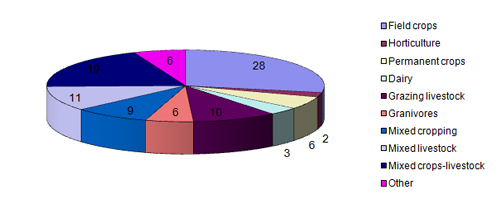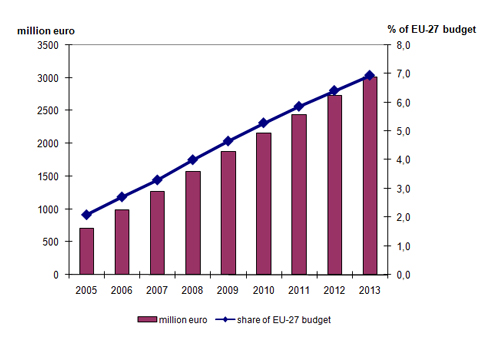Poland
• General country description
• A. First pillar: implementation of CAP reforms (2003)
• B. Second pillar: implementation of RDP measures during 2007-2013
• C. Vision for the CAP beyond 2013: a short overview of the debate (at Member State level) on future CAP reform
• D. Literature, sources, references
• The comparative analysis provides a compact overview of CAP implementation across all 27 Member States and their visions of the future of the CAP
General country discription
Poland |
Comparison with EU-25 |
Population, 2005 (*1,000,000): 38.2 |
8.3% of population in EU-25 |
Population density, 2003 (inh./km2): 122 |
118 in EU-25 |
GDP/capita, 2005 (PPS): 11.600 |
50% of GDP/capita in EU-25 |
Share agriculture in total employment, 2002 (%): 18 |
5% in EU-25 |
Share Utilized Agricultural Area in total land area, 2003 (%): 53 |
46% in EU-25 in 1998 |
Average farm size, 2005 (ha): 12 |
19 in EU-15 |
Number of farms, 2005 (*1000): 1082.7 |
16.5% of farms in EU-25 |
Source: own calculations based on Eurostat
Distribution of farming types, 2005 (% of total)

Source: own calculations based on Eurostat
EU funding for the Single Payment Scheme (SPS)
and the second pillar, 2007-2013

Funding according to CAP budget including Bulgaria and Romania.
Sources: Agra Europe (2007); CEU (2006); EC (2007a)
A. First pillar: implementation CAP reform (2003)
A.1 Single Payment Scheme
Model
Implementation in 2010. (Council Regulation 2012/2006).
Coupling measures
No information
Reason for selection
- to prevent a large administrative burden;
- according to the Accession Treaty - obligatory regional model.
A.2 EU budget for Single Payment Scheme (SPS) per year (National ceiling) 2005-2013

Source: 2005: EC (2006); 2006-2013: CEU (2006) and Agra Europe (2007)
Tradability of SPS
Single Payments are tradable at Member State level.
A.3 Cross-compliance: Good Agricultural and Environmental Conditions (GAEC)
(Source:IEEP 2005 )
Selected standards of the GAEC
Issue |
Standards |
Summary of farmers’obligations |
Soil erosion |
Minimum soil cover |
For arable land with slope > 20%: retain soil cover, no crop cultivation with ridge along the slope and no black fallow |
|
Minimum land management reflecting site-specific conditions |
crops or fallow on arable land |
|
Retain terraces |
for slopes > 20%: terrace farming recommended |
|
EXTRA: assess real and potential risk to soil erosion |
|
Soil organic matter |
Standards for crop rotation where applicable |
fallow land no longer than 5 years |
|
Arable stubble management |
no burning of stubble, meadows or pastures |
Minimum level of maintenance |
minimum livestock stocking rates or/and appropriate regimes |
grazing or mowing of grasslands in vegetation period, at least 1x year |
Avoiding the encroachment of unwanted vegetation on agricultural land |
no trees or shrubs on agricultural land, except if protected by Nature Protection law, or important for water and soil protection |
Poland pays attention to all issues of GAEC. Prevention of land abandonment is a priority, along with combating soil erosion on sloping ground.
Reason for selection of cross compliance standards
GAECs are according to current national practices.
A.4 Further reform of market regulations
Wine
Poland considers that reform of Wine Market Organization is needed. Main goals of the reform should be:
- increase of competitiveness of European wines vs third country wines,
- possibility of adding sugar during wine production process in regions where such addition is needed (because of weather conditions),
- crisis distillation of wines should be banned or become a crisis tool and not as today, when it is a regular procedure,
- simplification of labeling rules (more clear for the consumers),
- funds for Wine CMO should not be increased.
Fruit and vegetables
Poland requests for the application of a separate area payment to the sector of soft fruit intended for processing, functioning outside of the SAPS (Single Area Payment Scheme) financial envelope and intended exclusively for soft fruit producers.
Poland also calls for setting a transitional period to apply complete decoupling of support for producers of tomato for processing in the New Members States applying the SAPS.
As regards the impact of the reform, at present it is too early to assess its results, because the issue is still under discussion (in the course of meeting of the Council of the European Union in June 11-12, 2007 it is planned to reach a political agreement on Proposal for a Council Regulation laying down specific rules as regards the fruit and vegetable sector and amending certain regulations). (Decision made in Agricultural Council meeting in June 2007: Complete decoupling of processing of fruit and vegetables within 4 years for tomatoes and within 5 years for permanent crops (e.g. citrus). Role of producer organisation strengthened, especially in crisis prevention and -management. If SAPS is used in the new MS, the country is allowed to introduce a separate payment system for fruit and vegetables and a suitable reference period. A temporarely (5 years) extra support for the soft fruit sector in Poland is agreed.)
Decoupling of other products, like tobacco, hop etc.
Poland plans to apply following Complementary National Direct Payments from 2007:
For tobacco
- coupled payments - 60% of EU-15 payment for April 30, 2004;
- decoupled payments (on the farm) - rest of complementary payments in accordance with Treaty of Accession (10% in 2007 r., 20% in 2008 and 30% in 2009).
For hops
Due to the end of the transitional period, as it is mentioned in article 71 of Council Regulation no 1782/2003, hops growers will receive in 2007direct payments in two parts:
- SAPS rate - fully decoupled (40% of EU-15 level on April 30, 2004);
- CNDP coupled payments - 25% of EU-15 payment on April 30, 2004.
In total hops growers will receive payments on the level of 65%.
Simplification into one market regulation
In line with the current practice, technical simplification has gone hand in hand with the simplification of Community policies, and Poland fully supports this approach. However, the reverse is not acceptable. It would mean undermining the nature of technical simplification, as the Commission has often pointed out.
Poland considers intervention buying as part of the CMO in pigmeat and abolishing intervention goes beyond the bounds of technical simplification of the CAP. Removing it would constitute an element of policy reform. We should consider the possibility of using this instrument in future.
Furthermore, Poland is of the opinion that the organisation of the horizontal Management Committee should ensure transparency of its work and that Member States' expertise and experience will be taken into account in all sectors.
Poland expects that detailed issues, including ensuring reimbursement of travelling expenses of two national experts, will be regulated in the Rules of Procedure adopted by the Committee, pursuant to Council Decision No 1999/468/EC laying down the procedures for the exercise of implementing powers conferred on the Commission.
B. Second pillar: implementation of RDP measures 2007-2013
B.1 Programme level and approval
There is one national RDP. The Rural Development Committee (consisting of representatives of the 27 Member States) has approved the RDP for Poland on 25 July 2007.
B.2 Distribution of public budget over the axes (%)1)
axis 1: competitiveness |
axis 2: environment and land management |
axis 3: rural economy |
Axis 4: Leader |
42 |
33 |
20 |
5 |
1) Figures excluding Technical Assistance
Source: Own calculations based on Ministerstwo Rolnictwa i Rozwoju Wsi (2007)
B.3 Integration of Leader in axes 1, 2 and 3
Leader is a cross-sectional approach allowing for execution and implementation of objectives, in particular the objectives of Axis 3 (Ministry of Agriculture and Rural Development of Poland, 2006).
B.4 Local Action Groups (LAGs)
It is intended to create about 200 LAGs in the period 2007-2013, which will cover 50% of the Polish territory (Ministerstwo Rolnictwa i Rozwoju Wsi, 2007).
B.5 RDP budget 2007-2013 (million euros)
total public budget |
% co-financing EAFRD1) |
EAFRD budget |
Contribution private sector |
Total costs |
National top-ups |
17217.8 |
77 |
13230.0 |
7842.5 |
25060.4 |
0 |
1) % of co-financing may vary per axis
Source: Ministerstwo Rolnictwa i Rozwoju Wsi (2007)
B.6 Less Favoured Areas
In 2005, 52% of the Utilized Agricultural Area (UAA) (8,851,000 ha) was classified as Less Favoured Area (LFA) (CEU, 2005).
B.7 Drivers of RDP strategy
Fit within national policy. Try to implement EU rural development priorities as an addition to the national policy. Relevant policy documents are the National Development Strategy 2007-2015 and the National Strategic Reference Framework.*
* Information provided by Maciej Stadejek, Ministry of Agriculture and Rural Development of Poland, Warsaw.
C. Vision on the CAP beyond 2013*
C.1 Stages in the development of the CAP debate
Is there a debate about the CAP beyond 2013?
Yes, a debate was initiated among government and NGOs.
C2 Key issues in the debate
Components and role of the CAP
- Abolishment of the milk quota system.
Organisation of the CAP (first and second pillar)
- To maintain the current instruments of the CAP.
Financing of the CAP
- To maintain common financing of the CAP.
* Information provided by Wouter Verhey, Counsellor Agriculture, Nature and Food Quality, Netherlands Embassy, Warsaw and by Maciej Stadejek, Department of European Union and International Cooperation, Ministry of Agriculture and Rural Development, Warsaw.
D. Literature, sources, references
- Agra Europe (2007), "Threat of SFP cuts rises as NMS accede", Agra Europe Weekly, January 12
- Council of the European Union (CEU) (2005), Proposal for a Council Regulation on support for rural development by the European Agricultural Fund for Rural Development (EAFRD) - redefinition of intermediate less-favoured areas, Brussels, Working Party on Agricultural Structures and Rural Development, working document (7971/05), 15 April
- Council of the European Union (CEU) (2006), Council Regulation 1782/2003 (consolidated version - August 5, 2006), Annex VIII and VIIIa, Brussels
- European Commission (EC) (2006), 35th Financial Report on the European Agricultural Guidance and Guarantee Fund, Guarantee section, 2005 Financial Year, SEC(2006)1152
- European Commission (EC) (2007a), EU support for rural development 2007-2013; Pre-allocated funding under Heading 2 "Natural Resources" of the Financial Framework, Brussels: European Commission
- European Commission (EC) (2007b), Overview of the implementation of direct payments under the CAP in Member States Version February 2007, EC, DG for Agriculture and Rural Development
- IREAS Institute for Structural policy (2004), Cross-Compliance in Central and Eastern European Countries
- Ministerstwo Rolnictwa i Rozwoju Wsi (2007), Program Rozwoju Opbszarów wiejskich na lata 2007-2013, 2007
- Ministry of Agriculture and Rural Development of Poland (2006), National Strategic Plan for 2007-2013 Rural Development, version December 2006
